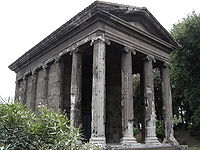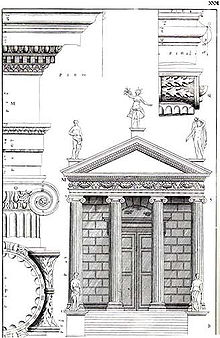
Temple of Portunus
Encyclopedia


The Temple of Portunus is an ancient building in Rome
Rome
Rome is the capital of Italy and the country's largest and most populated city and comune, with over 2.7 million residents in . The city is located in the central-western portion of the Italian Peninsula, on the Tiber River within the Lazio region of Italy.Rome's history spans two and a half...
, Italy
Italy
Italy , officially the Italian Republic languages]] under the European Charter for Regional or Minority Languages. In each of these, Italy's official name is as follows:;;;;;;;;), is a unitary parliamentary republic in South-Central Europe. To the north it borders France, Switzerland, Austria and...
, the main temple
Temple
A temple is a structure reserved for religious or spiritual activities, such as prayer and sacrifice, or analogous rites. A templum constituted a sacred precinct as defined by a priest, or augur. It has the same root as the word "template," a plan in preparation of the building that was marked out...
dedicated to the god Portunus
Portunes
In Roman mythology, Portunes was a god of keys, doors and livestock. He protected the warehouses where grain was stored...
in the city. It is in the Ionic order
Ionic order
The Ionic order forms one of the three orders or organizational systems of classical architecture, the other two canonic orders being the Doric and the Corinthian...
and is still more familiar by its erroneous designation, the Temple of Fortuna Virilis ("manly fortune") given it by antiquaries. Located in the ancient Forum Boarium
Forum Boarium
The Forum Boarium was the cattle forum venalium of Ancient Rome and the oldest forum that Rome possessed. It was located on a level piece of land near the Tiber between the Capitoline, the Palatine and Aventine hills. Here, too, is where the first bridges were built...
by the Tiber
Tiber
The Tiber is the third-longest river in Italy, rising in the Apennine Mountains in Emilia-Romagna and flowing through Umbria and Lazio to the Tyrrhenian Sea. It drains a basin estimated at...
, during Antiquity
Classical antiquity
Classical antiquity is a broad term for a long period of cultural history centered on the Mediterranean Sea, comprising the interlocking civilizations of ancient Greece and ancient Rome, collectively known as the Greco-Roman world...
the site overlooked the Port Tiberinus at a sharp bend in the river; from here, Portunus watched over cattle-barges as they entered the city from Ostia.
The temple was built c. 75 BCE and restored in the 1st century BC. The rectangular building consists of a tetrastyle portico
Portico
A portico is a porch leading to the entrance of a building, or extended as a colonnade, with a roof structure over a walkway, supported by columns or enclosed by walls...
and cella
Cella
A cella or naos , is the inner chamber of a temple in classical architecture, or a shop facing the street in domestic Roman architecture...
, raised on high podium
Podium
A podium is a platform that is used to raise something to a short distance above its surroundings. It derives from the Greek πόδι In architecture a building can rest on a large podium. Podia can also be used to raise people, for instance the conductor of an orchestra stands on a podium as do many...
reached by a flight of steps, which it retains. Like the Maison Carrée
Maison Carrée
The Maison Carrée is an ancient building in Nîmes, southern France; it is one of the best preserved temples to be found anywhere in the territory of the former Roman Empire.- History :...
in Nîmes
Nîmes
Nîmes is the capital of the Gard department in the Languedoc-Roussillon region in southern France. Nîmes has a rich history, dating back to the Roman Empire, and is a popular tourist destination.-History:...
, it has a pronaos portico
Portico
A portico is a porch leading to the entrance of a building, or extended as a colonnade, with a roof structure over a walkway, supported by columns or enclosed by walls...
of four Ionic columns across and two columns deep. The columns of the portico are free-standing, while the five columns on the long sides and the four columns at the rear are engaged
Engaged column
In architecture, an engaged column is a column embedded in a wall and partly projecting from the surface of the wall, sometimes defined as semi or three-quarter detached...
along the walls of the cella. This form is sometimes called pseudoperipteral, as distinct from a true peripteral temple like the Parthenon
Parthenon
The Parthenon is a temple on the Athenian Acropolis, Greece, dedicated to the Greek goddess Athena, whom the people of Athens considered their virgin patron. Its construction began in 447 BC when the Athenian Empire was at the height of its power. It was completed in 438 BC, although...
entirely surrounded by free-standing columns. It is built of tuff
Tuff
Tuff is a type of rock consisting of consolidated volcanic ash ejected from vents during a volcanic eruption. Tuff is sometimes called tufa, particularly when used as construction material, although tufa also refers to a quite different rock. Rock that contains greater than 50% tuff is considered...
and travertine
Travertine
Travertine is a form of limestone deposited by mineral springs, especially hot springs. Travertine often has a fibrous or concentric appearance and exists in white, tan, and cream-colored varieties. It is formed by a process of rapid precipitation of calcium carbonate, often at the mouth of a hot...
with a stucco
Stucco
Stucco or render is a material made of an aggregate, a binder, and water. Stucco is applied wet and hardens to a very dense solid. It is used as decorative coating for walls and ceilings and as a sculptural and artistic material in architecture...
surface.
The temple owes its state of preservation from its being converted to use as a church in 872
872
Year 872 was a leap year starting on Tuesday of the Julian calendar.- Europe :* Battle of Hafrsfjord: Harald Fairhair becomes the first king of Norway....
and rededicated to Santa Maria Egyziaca (Saint Mary of Egypt
Mary of Egypt
Mary of Egypt is revered as the patron saint of penitents, most particularly in the Eastern Orthodox, Oriental Orthodox, and Eastern Catholic churches, as well as in the Roman Catholic and Anglican churches.-Life:...
). Its Ionic order
Ionic order
The Ionic order forms one of the three orders or organizational systems of classical architecture, the other two canonic orders being the Doric and the Corinthian...
has been much admired, drawn and engraved and copied since the 16th century (see illustration, right). The original coating of stucco
Stucco
Stucco or render is a material made of an aggregate, a binder, and water. Stucco is applied wet and hardens to a very dense solid. It is used as decorative coating for walls and ceilings and as a sculptural and artistic material in architecture...
over its tufa and travertine construction has been lost.
The circular Temple of Hercules Victor
Temple of Hercules Victor
The Temple of Hercules Victor or Hercules Olivarius is an ancient edifice located in the Forum Boarium close to the Tiber in Rome. It is a monopteros, a round temple of Greek 'peripteral' design completely encircled by a colonnade...
is located south-east to the temple in the Forum Boarium.
The 18th-century Temple of Harmony
Temple of Harmony
The Temple of Harmony is an 18th-century folly in the grounds of Halswell House, Goathurst, Somerset, England.-Description:The Temple of Harmony is a 1767 replica of the 1st-century Temple of Fortuna Virilis in Rome...
in Somerset, England is a folly
Folly
In architecture, a folly is a building constructed primarily for decoration, but either suggesting by its appearance some other purpose, or merely so extravagant that it transcends the normal range of garden ornaments or other class of building to which it belongs...
based on the Temple of Portunus.

